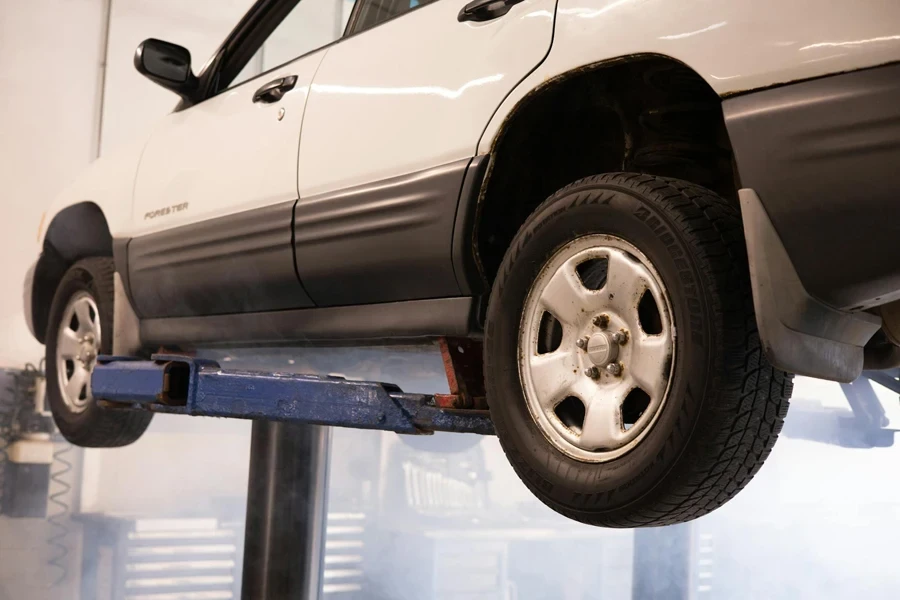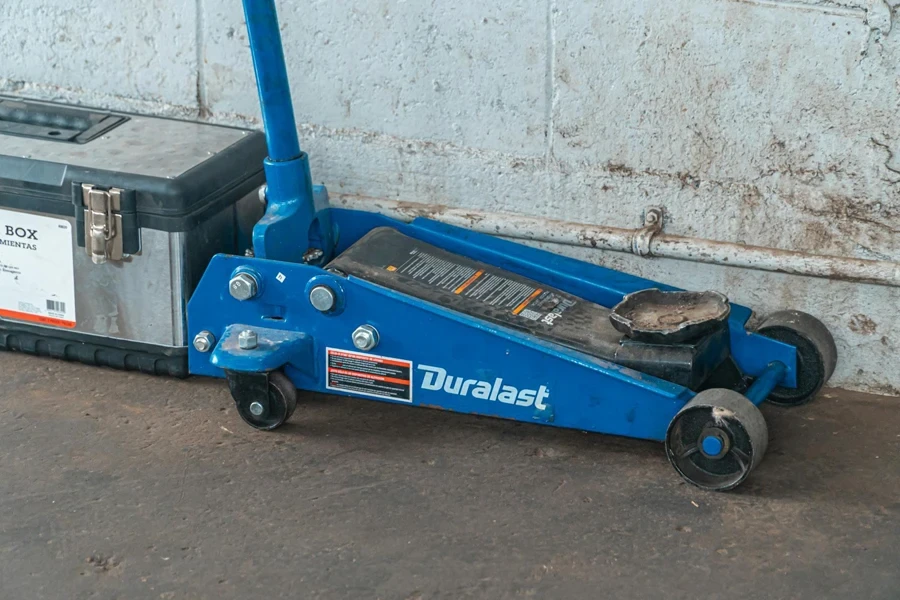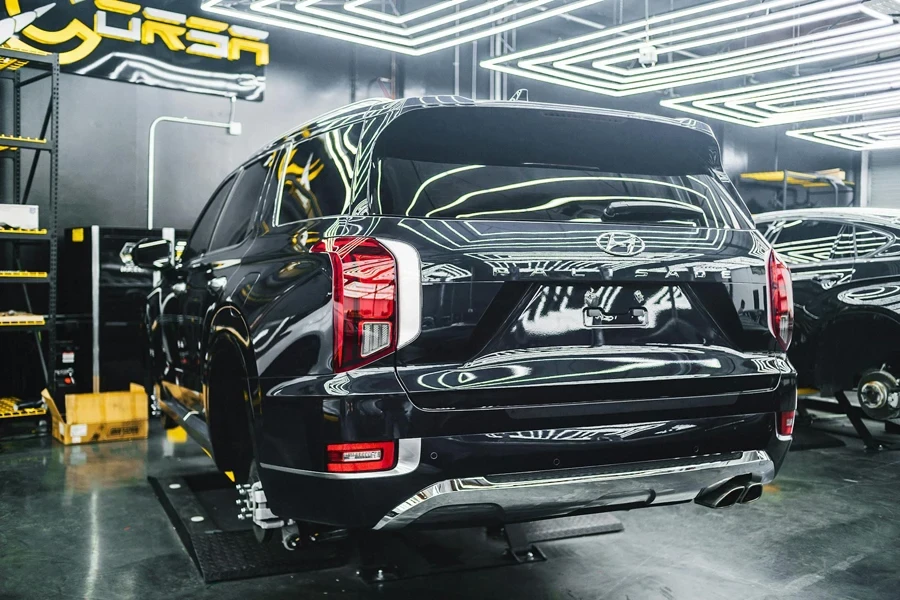Table of Contents
● Introduction
● Market overview
● Different types of car lifts and their features
● Things to consider when selecting car lifts
● Conclusion

Introduction
Car lifts are essential tools in the automotive industry, providing critical support for vehicle maintenance, repairs, and storage. Widely used in professional garages, workshops, and even home garages, these lifts enable mechanics and car enthusiasts to access the underside of vehicles with ease, enhancing efficiency and safety. The market offers various types of car lifts, each designed to meet specific needs, from heavy-duty four-post lifts for large vehicles to compact scissor lifts that save space. With the automotive lift market projected to grow significantly, driven by increased vehicle production and technological advancements, understanding the different types and their features is crucial. By making an informed choice, users can ensure their lift meets all operational requirements, contributing to a safer and more productive work environment.

Market overview
The global automotive lift market was valued at approximately USD 2.9 billion in 2022 and is projected to grow at a compound annual growth rate (CAGR) of 4.4%, reaching USD 4.5 billion by 2032, according to fact.mr. This growth is driven by rising disposable income, urban development, and increased vehicle production across both emerging and developed nations. The continuous increase in vehicle sales directly boosts the demand for automotive lifts essential for maintenance and repairs. With more vehicles on the road, the need for regular servicing and component replacements has surged, further propelling the market’s expansion.
Regionally, North America and Asia-Pacific dominate the market. North America, with its high vehicle ownership rate and stringent safety regulations, is expected to hold a significant market share, accounting for 6.5% of the global market by 2032, according to fact.mr. The Asia-Pacific region, particularly China and India, is experiencing rapid growth due to increasing car manufacturing and expanding automotive infrastructure. Europe also plays a crucial role, anticipated to capture 4.8% of the market share by 2032. Recent trends highlight the rise in hybrid and electric automotive lifts, catering to the evolving needs of modern vehicles. Technological advancements and the integration of smart features in lifts are also notable trends, enhancing the efficiency and safety of automotive maintenance. As the automotive sector continues to evolve, the demand for innovative and high-performance car lifts is expected to grow steadily.

Different types of car lifts and their features
Four-post car lifts
Four-post car lifts are widely used due to their robust construction and high weight capacity, typically supporting up to 20,000 lbs. These lifts are ideal for both storage and maintenance, allowing for easy under-car access. Commonly found in commercial garages and workshops, four-post lifts offer stability and versatility, making them suitable for heavy vehicles like trucks and SUVs. Their design often includes built-in safety features such as automatic locks and secondary safety systems to prevent accidental lowering. The durability and ease of use of four-post lifts make them a reliable choice for long-term use.
Two-post car lifts
Two-post car lifts are favored for their reliability and cost-effectiveness, making them a popular choice in automotive repair shops. These lifts provide full access to the vehicle’s underside, which is essential for a wide range of repair and maintenance tasks. Typically supporting weights up to 9,000 lbs, two-post lifts require less floor space and are generally less expensive than four-post lifts. According to kroftools, they are bolted to the floor and need periodic maintenance, but their efficient design allows for easy vehicle positioning and operation. These lifts also feature symmetrical or asymmetrical arm configurations, offering flexibility in handling different vehicle types.
Scissor car lifts
Scissor lifts are designed to maximize space by lying flat when not in use, making them ideal for small workshops and garages. These lifts are versatile and can be either above-ground or in-ground, with a weight capacity ranging from 6,000 to 10,000 lbs. Scissor lifts are praised for their stability and ease of use, particularly in environments where space is a premium. Their space-saving design does not compromise functionality, as they provide ample lifting height for most maintenance tasks. Scissor lifts are also available in portable versions, enhancing their utility.
Portable car lifts
Portable car lifts are highly valued for their mobility and ease of use, allowing them to be moved and operated in various locations. These lifts are typically suitable for smaller vehicles and support weights up to 6,000 lbs. Their compact design makes them ideal for home garages and small workshops where permanent installation is not feasible. According to kroftools, portable lifts enhance productivity by providing quick and easy access for minor repairs and maintenance, without requiring extensive setup. They often feature hydraulic or electric lifting mechanisms and can be stored away when not in use, saving space.
In-ground car lifts
In-ground car lifts offer a sleek and space-efficient solution, typically used in high-end automotive shops and showrooms. These lifts are installed below the garage floor, providing a clean and unobstructed workspace when not in use. They are suitable for lifting heavier vehicles and often feature advanced hydraulic systems for smooth operation. According to The lift blog, in-ground lifts require professional installation and regular maintenance, but offer superior aesthetics and functionality for upscale environments. They can be configured with single or dual hydraulic cylinders, and their design can include features such as retractable arms and rotating platforms.
Other types
Other types of car lifts include alignment car lifts, mobile column lifts, and parking lifts. Alignment car lifts are specifically designed for precise wheel alignment services, featuring integrated turn plates and slip plates. Mobile column lifts provide flexibility by allowing multiple columns to be used in various configurations to lift heavy and large vehicles like buses and trucks. These lifts are often wireless and battery-powered, enhancing their mobility and ease of use. Parking lifts, such as those used in residential garages, maximize vertical space by stacking vehicles. According to harding APS, these lifts are essential for optimizing space in urban areas where real estate is limited. They come in various configurations, including single-post, double-post, and platform designs, to accommodate different parking needs.

Things to consider when selecting car lifts
Safety features
Safety features are critical when selecting a car lift, ensuring both the operator’s and vehicle’s protection during use. Essential safety mechanisms include automatic locks that prevent accidental descent, emergency stop buttons for immediate halting of operations, and overload alarms to alert when the lift is handling more weight than it is designed for. Robust construction is equally important, reducing the risk of structural failure. These features significantly enhance the overall safety and reliability of the lift. Proper adherence to safety standards and regular maintenance checks are vital in preventing mishaps and ensuring the long-term functionality of the car lift.
Weight capacity and lifting height
Determining the appropriate weight capacity and lifting height is essential for selecting a suitable car lift. The lift must support the heaviest vehicle intended to service, with capacities ranging from 6,000 lbs for smaller lifts to over 20,000 lbs for heavy-duty models. Ensuring the lift’s height capability provides adequate clearance for various maintenance tasks, enhancing both safety and ergonomics. Balancing these factors is critical for efficient and practical use, accommodating a wide range of vehicles and maintenance activities.
Usability and convenience
Usability and convenience significantly affect a car lift’s efficiency. Features such as intuitive controls, adjustable arms, and tool trays enhance the user experience, making maintenance tasks simpler and quicker. Lifts with quick-release mechanisms and easy mobility expand their utility, especially in garages with limited space. A user-friendly lift reduces operational complexity, allowing for smoother and faster maintenance procedures, ultimately boosting productivity in automotive workshops.
Durability and maintenance
The longevity of a car lift is heavily influenced by its build quality and the materials used in its construction. High-grade materials and engineering designed for resilience ensure the lift can withstand regular use and environmental factors. Regular maintenance, such as hydraulic system checks and structural assessments, is vital for prolonging the lift’s lifespan. Maintaining the lift in accordance with the manufacturer’s guidelines, including routine inspections and avoiding overloading, helps prevent premature wear and costly repairs.
Cost and budget
Balancing cost with quality is crucial when selecting a car lift. While higher-quality lifts may require a larger initial investment, they often provide long-term savings by reducing the need for frequent repairs or replacements. Understanding the long-term value versus the initial investment helps in making an informed decision. A well-chosen lift that meets all necessary safety, usability, and durability criteria will ultimately offer a more economical solution, ensuring reliable and efficient service over time.
Installation and space requirements
Proper installation and adequate space are critical considerations when selecting a car lift. The lift must fit within the available space in the garage or workshop, with sufficient room for safe operation. According to the lift blog, some lifts, like in-ground and scissor lifts, require specific installation conditions, such as reinforced concrete floors or below-ground pits. Ensuring the lift is installed by certified professionals guarantees compliance with safety standards and optimal performance. Additionally, planning the layout of the workspace to accommodate the lift’s dimensions and operational range is essential for maximizing efficiency and safety.

Conclusion
Selecting the right car lift requires a thorough understanding of market trends, the various types available, and crucial selection criteria. Key considerations include safety features like automatic locks and overload alarms, which ensure operational safety. It’s essential to determine the appropriate weight capacity and lifting height to accommodate different vehicles and maintenance tasks. Usability features such as intuitive controls and adjustable arms enhance efficiency, while high-grade materials and robust construction ensure durability and ease of maintenance. Balancing cost with long-term value is vital, as investing in a high-quality lift can lead to significant savings over time. By evaluating these factors, one can make an informed decision that ensures safety, efficiency, and long-term satisfaction, ultimately contributing to a more productive and secure automotive maintenance environment.




